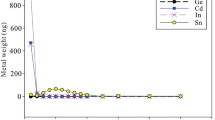Abstract
The method developed for cesium concentration from large freshwater samples was tested and adapted for analysis of cesium radionuclides in seawater. Concentration of dissolved forms of cesium in large seawater samples (about 100 L) was performed using composite absorbers AMP-PAN and KNiFC-PAN with ammonium molybdophosphate and potassium–nickel hexacyanoferrate(II) as active components, respectively, and polyacrylonitrile as a binding polymer. A specially designed chromatography column with bed volume (BV) 25 mL allowed fast flow rates of seawater (up to 1,200 BV h−1). The recovery yields were determined by ICP-MS analysis of stable cesium added to seawater sample. Both absorbers proved usability for cesium concentration from large seawater samples. KNiFC-PAN material was slightly more effective in cesium concentration from acidified seawater (recovery yield around 93 % for 700 BV h−1). This material showed similar efficiency in cesium concentration also from natural seawater. The activity concentrations of 137Cs determined in seawater from the central Pacific Ocean were 1.5 ± 0.1 and 1.4 ± 0.1 Bq m−3 for an offshore (January 2012) and a coastal (February 2012) locality, respectively, 134Cs activities were below detection limit (<0.2 Bq m−3).



Similar content being viewed by others
References
Buesseler KO, Casso SA, Hartman MC, Livingston HD (1990) Determination of fission-products and actinides in the Black Sea following the Cherynobyl accident. J Radioanal Nucl Chem Art 138:33–47
Kim CK, Kim CS, Yun JY, Kim KH (1997) Distribution of 3H, 137Cs and 239,240Pu in the surface seawater around Korea. J Radioanal Nucl Chem 218:33–40
Aoyama M, Hirose K, Miyao T, Igarashi Y (2000) Low level 137Cs measurements in deep seawater samples. Appl Radiat Isot 53:159–162
Mohanrao GJ, Folsom TR (1963) Gamma-ray spectrometric determination of low concentrations of radioactive caesium in sea water by a nickel ferrocyanide method. Analyst 88(1043):105–108
Ahmad Z, Wan Mahmood ZU, Shahar H, Yii MW, Abu Bakar AS (2011) Radioactivity in the Exclusive Economic Zone of east coast Peninsular Malaysia: distribution trends of 137Cs in surface seawater. J Radioanal Nucl Chem 287:329–334
Yii MW, Wan Mahmood ZU (2011) Radioactivity of plutonium isotopes, 137Cs and their ratio in sediment, seawater and biota from the east coast of Peninsular Malaysia. J Radioanal Nucl Chem 289:819–833
Gaur S (1996) Determination of Cs-137 in environmental water by ion-exchange chromatography. J Chromatogr A 733:57–71
Mann DR, Casso SA (1984) In situ chemisorption of radiocesium from seawater. Mar Chem 14(4):307–318
Sartandel SJ, Jha SK, Puranik VD (2012) Constrains in gamma spectrometry analysis of fallout 137Cs in coastal marine environment of Arabian sea in India. J Radioanal Nucl Chem 292(3):995–998
Boni AL (1966) Rapid ion exchange analysis of radiocesium in milk, urine, sea water, and environmental samples. Anal Chem 38:89–92
Bailly du Bois P, Laguionie P, Boust D, Korsakissok I, Didier D (2012) Estimation of marine source-term following Fukushima Dai-ichi accident. J Environ Radioact. doi:10.1016/j.jenvrad.2011.11.015
Duran EB, Povinec PP, Fowler SW, Airey PL, Hong GH (2004) 137Cs and 239+240Pu levels in the Asia-Pacific regional seas. J Environ Radioact 76:139–160
Hirose K, Aoyama M (2003) Analysis of 137Cs and 239,240Pu concentrations in surface waters of the Pacific Ocean. Deep Sea Res II 50:2675–2700
Buesseler K, Aoyama M, Fukasawa M (2011) Impacts of the Fukushima nuclear power plants on marine radioactivity. Environ Sci Technol 45:9931–9935
Šebesta F (1997) Composite sorbents of inorganic ion-exchangers and polyacrylonitrile binding matrix I. Methods of modification of properties of inorganic ion-exchangers for application in column packed beds. J Radioanal Nucl Chem 220(1):77–88
John J, Šebesta F, Motl A (1999) Application of new inorganic-organic composite absorbers with polyacrylonitrile binding matrix for separation of radionuclides from liquid radioactive wastes. In: Choppin GR, Khankhasayev MKh (eds) Chemical separation technologies and related methods of nuclear waste management. Kluwer, Dordrecht, pp 155–168
Šebesta F (1989) The device and method used for fast concentration of dissolved forms of radioactive cesium from large-volumetric water samples. Rádioaktivita a životné prostredie 12(4):181–187 (in Czech)
Šebesta F, Štefula V (1990) Composite ion exchanger with ammonium molybdophosphate and its properties. J Radioanal Nucl Chem Art 140(1):15–21
Kameník J, Šebesta F (2003) Comparison of some commercial and laboratory prepared caesium ion-exchangers. Czech J Phys 53(Suppl 1):A571–A576
Kameník J, Škrkal J, Rulík P (2009) Long term monitoring of 137Cs in foodstuffs in the Czech Republic. Appl Radiat Isot 67(5):974–977
Bartusková M, Pospíšilová H, Lušňák J, Malátová I (2007) Ingestion doses for a group with higher intake of 137Cs. In: IRPA regional congress for Central and Eastern Europe, Brasov, Romania
Révay Z, Belgya T, Ember PP, Molnár GL (2001) Recent developments in HYPERMET PC. J Radioanal Nucl Chem 248(2):401–405
Currie LA (1968) Limits for qualitative detection and quantitative determination, application to radiochemistry. Anal Chem 40(3):586–593
Folsom TR, Feldman C, Rains TC (1964) Variation of cesium in the ocean. Science 144(3618):538–539
Acknowledgments
The authors wish to acknowledge the help of Denys Vonderhaar and Gregory Ravizza with stable cesium analysis. This material is based upon work supported by NSF under grant No. RAPID OCE-1137412 and the School of Ocean Earth Science and Technology, University of Hawaii. Any opinions, findings, and conclusions or recommendations expressed in this material are those of the authors and do not necessarily reflect the views of the funding agencies.
Author information
Authors and Affiliations
Corresponding author
Rights and permissions
About this article
Cite this article
Kameník, J., Dulaiova, H., Šebesta, F. et al. Fast concentration of dissolved forms of cesium radioisotopes from large seawater samples. J Radioanal Nucl Chem 296, 841–846 (2013). https://doi.org/10.1007/s10967-012-2007-4
Received:
Published:
Issue Date:
DOI: https://doi.org/10.1007/s10967-012-2007-4




